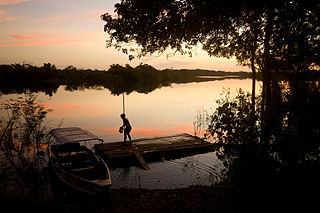
Amazonas is a state of Brazil, located in the North Region in the north-western corner of the country. It is the largest Brazilian state by area and the ninth-largest country subdivision in the world. It is the largest country subdivision in South America, being greater than the areas of Chile, Paraguay, and Uruguay combined. Mostly located in the Southern Hemisphere, Amazonas is the third-largest country subdivision in the Southern Hemisphere after the Australian states of Western Australia and Queensland. Located entirely in the Western Hemisphere, it is the fourth-largest country subdivision in the Western Hemisphere after Greenland, Nunavut, and Alaska. If independent, Amazonas could become the sixteenth-largest country in the world, slightly larger than Mongolia. Neighbouring states are Roraima, Pará, Mato Grosso, Rondônia, and Acre. It also borders the nations of Peru, Colombia and Venezuela. This includes the Departments of Amazonas, Vaupés and Guainía in Colombia, as well as the Amazonas state in Venezuela, and the Loreto Region in Peru.

The Rio Negro, or Guainía as it is known in its upper part, is the largest left tributary of the Amazon River, the largest blackwater river in the world, and one of the world's ten largest rivers by average discharge.

Manaus is the capital and largest city of the Brazilian state of Amazonas. It is the seventh-largest city in Brazil, with an estimated 2020 population of 2,219,580 distributed over a land area of about 11,401 km2 (4,402 sq mi). Located at the east centre of the state, the city is the centre of the Manaus metropolitan area and the largest metropolitan area in the North Region of Brazil by urban landmass. It is situated near the confluence of the Negro and Amazon rivers. It is one of the two cities in the Amazon Rainforest with a population of over 1 million people, alongside Belém.

Solimões is the name often given to upper stretches of the Amazon River in Brazil from its confluence with the Rio Negro upstream to the border of Peru. The Solimões flows for about 1,600 km through a floodplain about 80 km wide.
Araçá River is a river of Amazonas state in north-western Brazil. It is a tributary of the Demini River, which in turn is a tributary of the Rio Negro.
The Carabinani River (Portuguese: Rio Carabinani is a river in the Amazonas state in north-western Brazil. It is a right tributary of the Jaú River

Içana River is a tributary of the Rio Negro in South America. Its source is in the Guainía Department of Colombia, where it is known as the Isana River. From its source, it flows mostly east until it reaches the border between Colombia and Brazil, where the river forms a small part of the boundary between the two countries. From the border, it flows mostly southeast through Amazonas state until it joins the Rio Negro at Missão Boa Vista.

The Ituí River is a river of the upper Amazon Basin. It traverses some 370 km of the Atalaia do Norte municipality in the Amazonas state of north-western Brazil. It drains a very low gradient, dropping hardly 100 m over its whole extent, which results in extensive meandering. The Rio Negro, Beija-flor and Branquinho are some of its western tributaries, while the Rio Novo is its main eastern tributary. Downstream it joins the Itaquai River to form the upper Solimões.

Jaú River is a river of Amazonas state in north-western Brazil. It is a tributary of the Rio Negro, which itself is a tributary of the Amazon River.
The Unini River is a river of Amazonas state in north-western Brazil. It is a right tributary of the Rio Negro.

Vaupés River is a tributary of the Rio Negro in South America. It rises in the Guaviare Department of Colombia, flowing east through Guaviare and Vaupés Departments. It forms part of the international border between the Vaupés department of Colombia and the Amazonas state of Brazil. On the border it merges with the Papurí River and becomes known as the Uaupés. In 1847 an explorer saw a rapid which hurled its waves 12 or 15 metres in the air, "as if great subaqueous explosions were taking place." The river continues on east through the Alto Rio Negro Indigenous Territory until it flows into the Rio Negro at São Joaquim, Amazonas. Vaupés is a blackwater river.
The Xié River is a river of Amazonas state in north-western Brazil. It is a right tributary of the Rio Negro.

The Journalist Phelippe Dahsou Bridge is the fourth longest bridge in Brazil at 3,595-metre (11,795 ft) long with a cable-stayed bridge section of 400-metre over the Rio Negro that links the cities of Manaus and Iranduba in the state of Amazonas in Brazil. It spans the Rio Negro just before its confluence with the Amazon River, and is the only major bridge across the Amazon or any tributary in the Amazon basin. Its construction was marked by controversy over the potential effects of roadbuilding in the Amazon basin, which could lead to deforestation. A 2018 study found that the construction of this bridge did induce deforestation.
Rio Negro State Park South Section is a State park in the state of Amazonas, Brazil. It protects an area of Amazon rainforest to the east of the Rio Negro that is home to the endangered pied tamarin. The area was reduced in 2001 and was further reduced in 2014 to create a sustainable development reserve for the people that had been living there since before the park was created.
The Pira-tapuya, or variations like Pira-Tapuia, Piratapuyo, etc., or Tapuya for short, are an indigenous people of the Amazon regions. They live along the Vaupés River in Colombia and in the state of Amazonas, Brazil.
Guariba River is a river of Amazonas state in western Brazil. It is a tributary of the Pauini River, which itself is indirectly a tributary of the Rio Negro.








